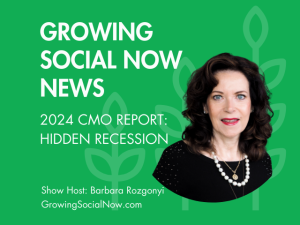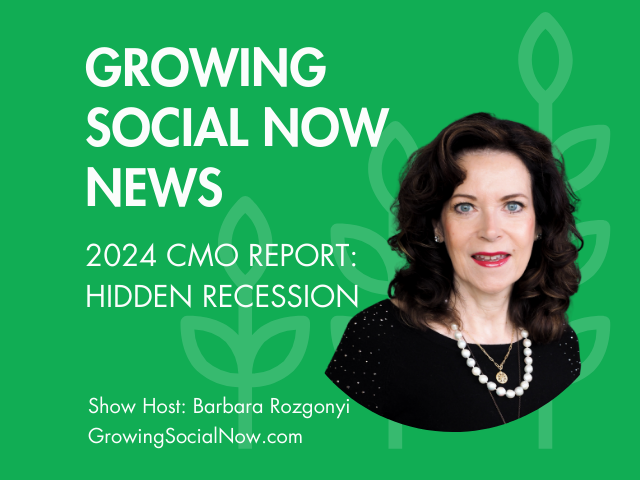 In the latest episode of Growing Social Now News, hosted by Barbara Rozgonyi, we delve deep into the current state of the marketing world. Despite a flourishing stock market, an exclusive survey by Bospar, CMO Huddles, and Redpoint reveals that 69% of 121 CMOs believe their industry is in a recession. This episode unpacks the hidden challenges and provides actionable strategies for marketers to navigate these turbulent times. For more marketing news and intriguing marketing PR expert interviews, subscribe to our podcast YouTube channel.
In the latest episode of Growing Social Now News, hosted by Barbara Rozgonyi, we delve deep into the current state of the marketing world. Despite a flourishing stock market, an exclusive survey by Bospar, CMO Huddles, and Redpoint reveals that 69% of 121 CMOs believe their industry is in a recession. This episode unpacks the hidden challenges and provides actionable strategies for marketers to navigate these turbulent times. For more marketing news and intriguing marketing PR expert interviews, subscribe to our podcast YouTube channel.
Is there really a recession for CMOs in the marketing world?
When we look at the U.S. economy, the S&P 500 has shown significant growth since the beginning of 2024. However, the surveyed CMOs paint a different picture. A substantial 69% of them feel that their industry is facing a recession, with budget cuts, extended deal cycles, and significant layoffs being the main culprits. These findings underscore the disconnect between stock market performance and the real-world struggles within the marketing sector.
The Drivers Behind 2024 Marketing Budget Cuts
One of the primary drivers of budget cuts is higher interest rates and inflationary pressures. According to Deloitte, 52% of companies have reported a decrease in marketing spending, with only 16.6% seeing an increase. This reduction in spending has led to underwhelming progress on digital transformation, making it challenging for CMOs to secure budget approvals. Gartner’s 2023 CMO Spend and Strategy Survey further highlights that 70% of CMOs feel that a lack of sufficient budget or resources is hampering their efforts to deliver successful marketing.
Impact of Media Spending on CMOs and Marketing Budgets
The impact of budget cuts extends beyond just financial constraints. Research by Analytic Partners shows that brands cutting media spending saw an 18% reduction in sales, while those maintaining or increasing their budgets enjoyed a 54% ROI. This stark contrast illustrates the importance of continued investment in media spending, especially during tough economic times. Companies that maintain their marketing budgets can capture more market share as their competitors cut back, leading to higher returns on investment.
Extended Deal Cycles Affect CMOs, Marketing and Sales
Another significant challenge facing CMOs is the elongation of deal cycles. Extended deal cycles require more touchpoints, content, and effort from marketing teams. The survey found that 54% of CMOs reported longer deal cycles, with startups experiencing a 36% increase in sales cycle length. Reducing a deal cycle from four months to three months can boost annual recurring revenue by 46%, and shortening it to two months can lead to a staggering 143% increase. This highlights the critical need for smart marketers to find ways to expedite deal cycles to drive revenue growth.
CMO Staffing Cuts and Marketing Layoffs
Staffing cuts and layoffs are also taking a toll on marketing departments. Half of the surveyed marketers experienced layoffs, and 41% saw marketing department cuts. Marketing is often seen as a cost center rather than a revenue generator, making it an easy target for budget cuts. Companies like Amazon are shifting marketing dollars to generative AI, reducing the need for staff. This trend is contributing to the high levels of stress and pressure on CMOs, with 69% being asked to do more with less and 76% under more pressure to deliver pipeline results.
Personal and Professional Toll on CMOs
The personal and professional toll on CMOs is significant. The survey reveals that 67% of CMOs reported a negative impact on their overall well-being, with 80% getting less exercise, 50% eating less healthily, and 40% experiencing weight gain while 15% suffered from mental health issues due to stress. The high-pressure environment is exacerbated by a decline in CMO job postings, which dropped 62% in the U.S. and 40% globally from February 2023 to February 2024. Companies are consolidating marketing roles under titles like COO, Chief Growth Officer (CGO), or Chief Revenue Officer (CRO) to streamline leadership and reduce perceived redundancies.
Strategies for CMOs
Despite these challenges, there are strategies that CMOs can adopt to navigate these turbulent times. One approach is to expand the CMO role to include internal communications, customer experience, customer success, AI transformation, and even sales. This broadens the scope of the CMO’s responsibilities and demonstrates their value beyond traditional marketing functions. Additionally, CMOs should develop metrics to show marketing’s impact beyond the pipeline, including its effects on employees, customers, prospects, and partners.
Another critical strategy is to focus on one big idea that can drive significant results. This could involve leveraging AI implementation, which is seen as a game-changer in the marketing world. AI can help automate processes, provide valuable insights, and enhance customer experiences, making it a valuable tool for CMOs looking to maximize their impact with limited resources.
The concept of rapid refresh by CoryWest Media is also gaining traction as a way to quickly reinvent a company’s digital presence. By reworking branding, websites, PR, and messaging swiftly, companies can stay agile and responsive to market changes. This approach helps maintain momentum and relevance in a fast-paced business environment.
In conclusion, the underground recession in the marketing world presents significant challenges, but also opportunities for those willing to adapt and innovate. CMOs who embrace expanded roles, focus on impactful strategies, and leverage new technologies will be best positioned to thrive. Tune in to this episode of Growing Social Now News for a deep dive into these insights and more.
Thanks so much to Bospar for giving us access to the CMO report. Please note that all statistics quoted are taken from the report, which is one you definitely want to study and read. How do your 2024 marketing results compare?

